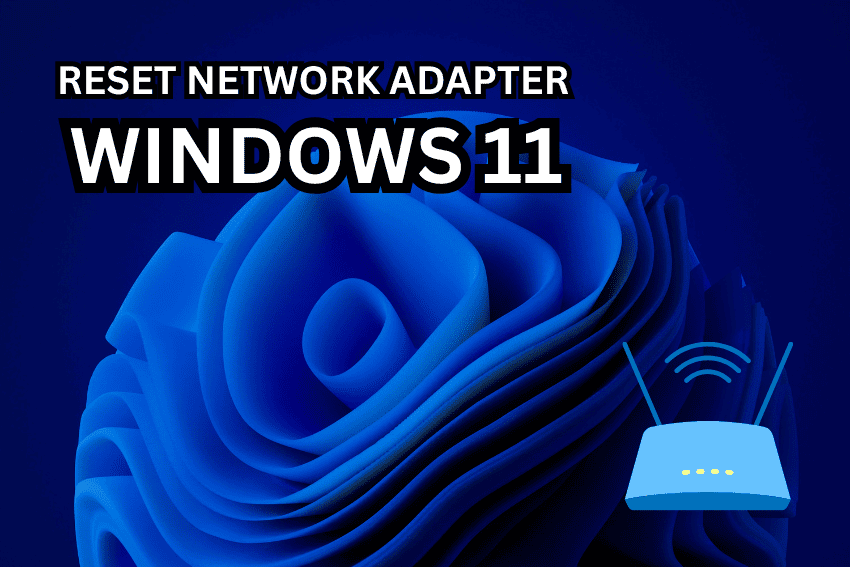Resetting your Windows 11 network adapter can be a lifesaver when you’re dealing with pesky internet connection issues, slow speeds, or dropped signals. It might be a Wi-Fi or ethernet that has been performing poorly so one of the ways to go about it is to reset a network adapter as it will do the same by restoring the settings to default and clearing up a corrupted setting.

In this article, I will walk you through the process of resetting your Windows 11 network adapter in a way that’s easy to follow, even if you’re not a tech wizard. And I will offer few tricks to make sure your network is restored and running normally again.
Why You Might Need to Reset Your Windows 11 Network Adapter
Before diving into the how-to, I thought we should discuss why you may want to reset your network adapter in Windows 11. The part of hardware that helps you to access the internet is your network adapter either via Wi-Fi connection or the use of an Ethernet connection. Settings may have been misconfigured, drivers may be outdated, or connectivity may experience temporary glitches over the course of time. The following are some typical situations when a reset may be useful:
- Intermittent or no internet connection: Your Wi-Fi keeps dropping, or your Ethernet cable isn’t registering.
- Slow network speeds: Pages take forever to load, or streaming buffers endlessly.
- Network conflicts: Multiple devices or software interfere with your connection.
- Driver issues: Outdated or corrupted drivers are causing connectivity hiccups.
Resetting the network adapter in windows 11 basically reboots the network components, removes cached settings and reinstalls the adapter allowing you a fresh start to work with.
Step-by-Step Guide to Reset Windows 11 Network Adapter
Here’s how to reset your Windows 11 network adapter using multiple methods. I will start with using the simpler way and opt to use the more complex alternatives in case of necessity. These are the steps you could follow, and you should not take long to find your network again.
Method 1: Use the Network Reset Feature in Windows 11
Windows 11 does contain an in-built network resetting tool which is user-friendly and efficacious. The technique restores network adapters, cleans the network settings and re-installs network adapters automatically. Notice that this will clean up all the saved Wi-Fi passwords and VPN set-ups so have those ready.
Open Settings:
- Click the Start button (Windows icon) in the taskbar.
- Select Settings (gear icon) or press Windows + I to open it directly.
Navigate to Network & Internet:
- In the Settings window, click Network & internet on the left sidebar.
- Scroll down and select Advanced network settings.
Find Network Reset:
-
- In the Advanced network settings menu, scroll to the bottom and click Network reset.
Initiate the Reset:
- Click the Reset now button next to “Network reset.”
- A pop-up will warn you that this will remove all network adapters and reset networking components. Click Yes to confirm.
Restart Your Computer:
- Windows will log you out and restart your PC. This process may take a minute or two.
- After the restart, Windows will automatically reinstall your network adapters.
Reconnect to Your Network:
- Once your PC boots up, reconnect to your Wi-Fi network by entering the password or plugging in your Ethernet cable.
- Test your connection by opening a browser or pinging a website (e.g., ping google.com in Command Prompt).
To most users, this approach is the most common one since it is easy and does not require technical skills. But when it fails to solve your problem then the other option is to go by the second option.
Method 2: Disable and Enable the Network Adapter
If you need something less invasive as a complete reset of a network, you do have a manual option of disabling and re-enabling your network adapter. This can repair small bugs without clearing out all of the network settings.
Open Device Manager:
- Right-click the Start button and select Device Manager, or press Windows + X and choose it from the menu.
Locate Your Network Adapter:
- Expand the Network adapters section by clicking the arrow next to it.
- Find your network adapter (e.g., “Intel(R) Wi-Fi 6 AX201” for Wi-Fi or “Realtek PCIe GbE Family Controller” for Ethernet).
Disable the Adapter:
- Right-click the adapter and select Disable device.
- Wait a few seconds for the adapter to deactivate.
Re-enable the Adapter:
- Right-click the same adapter again and select Enable device.
- Wait for Windows to reactivate the adapter, then test your internet connection.
This is a fast way which usually fixes the network adapter temporary problems in Windows 11.
Method 3: Update or Reinstall Network Adapter Drivers
If resetting or toggling the adapter does not help, then it could be the problem of old outdated or corrupt drivers. And here is how to update or reinstall them.
Open Device Manager:
- As before, right-click the Start button and select Device Manager.
Update the Driver:
- Expand Network adapters and right-click your adapter.
- Select Update driver > Search automatically for drivers.
- Windows will check for and install any available updates. If none are found, proceed to reinstall the driver.
Reinstall the Driver:
- Right-click the adapter and select Uninstall device.
- Confirm the uninstallation, then restart your computer.
- Windows will automatically reinstall the default driver upon reboot.
Optional: Download Latest Drivers:
- If the default driver doesn’t work, visit the manufacturer’s website (e.g., Intel, Realtek, or your PC’s brand like Dell or HP) to download the latest driver for your specific adapter model.
- Install the driver by following the manufacturer’s instructions, then restart your PC.
Method 4: Reset Network Settings via Command Prompt
In case you are good with command-line, you can reset network on the go through the use of Command Prompt. The approach resets the TCP/IP options, DNS cache, and other networking configurations.
Open Command Prompt as Administrator:
- Type cmd in the Windows search bar, right-click Command Prompt, and select Run as administrator.
Run Network Reset Commands:
- Enter the following commands one by one, pressing Enter after each:
netsh winsock reset netsh int ip reset ipconfig /release ipconfig /renew ipconfig /flushdns
Restart Your Computer:
- After running all commands, restart your PC to apply the changes.
- Reconnect to your network and test the connection.
The method can also be specific in solving the deeper configuration problems pertaining to the network configuration that may not be sorted via a standard reset.
Tips to Prevent Future Network Issues
Once you’ve successfully reset your Windows 11 network adapter, here are some tips to keep your network running smoothly:
- Keep Drivers Updated: Regularly check for driver updates through Device Manager or your manufacturer’s website.
- Restart Your Router: If your PC’s network adapter is fine but issues persist, reboot your router or modem.
- Use Windows Troubleshooter: Go to Settings > System > Troubleshoot > Other troubleshooters and run the Network Adapter or Internet Connections troubleshooter.
- Avoid Conflicting Software: Some VPNs or third-party firewalls can interfere with your network. Temporarily disable them to test.
- Check for Windows Updates: Ensure your Windows 11 system is up to date by going to Settings > Windows Update > Check for updates.
Conclusion
Resetting your Windows 11 network adapter is a powerful troubleshooting step that can resolve a wide range of connectivity issues, from dropped Wi-Fi signals to slow internet speeds. Always deactivating and reactivating the network or running network reset commands will help get your network back on track.
Just to remember, you should update your drivers to keep your network running properly and regularly check the settings to prevent any issue in the future. In case you have some problems even after doing all these approaches, it would be time to contact your ISP or a competent technician.
FAQs About Resetting Windows 11 Network Adapter
Here are some frequently asked questions to help you better understand the process of resetting your Windows 11 network adapter.
Will resetting my network adapter delete my files?
No, when you reset the network adapter you just change the settings and configurations of the network. It does not interfere with your personal files and apps among other data.
Do I need to back up my Wi-Fi passwords before a network reset?
Yes, Wi-Fi passwords stored are deleted with a complete network reset (Method 1). You should now make sure that you have your Wi-Fi credentials in your possession.
How long does a network reset take in Windows 11?
The process of reset also lasts about 1-2 minutes after which the system starts. Another minute may be required to reinstall adapters and connect to your network.
What if resetting the network adapter doesn’t fix my issue?
In case the reset fails, you can update or reinstall drivers (Method 3), access a Command Prompt reset (Method 4) or contact your ISP in case of router problems.
Can I undo a network reset?
You can’t directly undo a network reset, but you can manually reconfigure your network settings, including re-entering Wi-Fi passwords, or connecting to a VPN.


